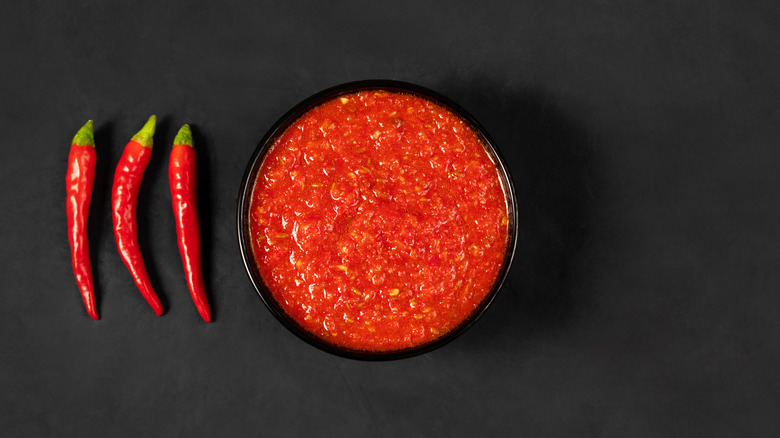The Very First Versions Of Hot Sauce Were Incredibly Simple
Hot sauce is one of the trendiest foods of the 21st century, with countless viral videos of red-faced, sweaty souls taking on spicy challenges and an ever-growing number of brands vying for the title of world's hottest hot sauce. Plus, condiment creators are constantly experimenting with new ingredients, and you can now find hot sauces that incorporate a wide range of fruit juices, chocolate, and even bacon. If we could exchange these crazy concoctions with history's first hot sauce eaters, they would scarcely recognize what they tasted, and the same would apply to us if we tried the original version of the condiment. You see, early iterations of hot sauce were about as simple as food can get... except, they weren't necessarily used for food back then.
Archeological evidence of hot sauce-making dates back thousands of years, although nobody is completely certain where, when, and by whom it was invented. We know that hot sauce originated in the same place as chili peppers, the region between modern-day Mexico and Bolivia. Early Mesoamerican societies paved the way for our spice addictions by domesticating chili peppers. While it is not known exactly which group deserves credit for this advancement, there is ample evidence showing that both the Maya and the Aztecs consumed chilis; in fact, the word 'chili' itself is taken from Nahuatl, the Aztec language. Both cultures appear to have made rudimentary versions of hot sauce, but they probably didn't use it for the same reason we do today.
The earliest hot sauce had just two ingredients
When the Maya and Aztecs ate chili peppers, flavor wasn't the main thing on their minds. It was their health. They believed that chilis had medicinal properties, and used them to treat a wide range of ailments, including stomach aches, rashes, and toothaches. They were actually onto something here, as modern medical research has revealed that capsaicin, the chemical responsible for spiciness, has anti-inflammatory properties, and a diet rich in chili peppers has been linked to lower rates of cardiovascular disease and may even increase longevity.
Beyond medicine, the earliest versions of hot sauce were even used in weaponry, harnessing their mighty burn for sadistic purposes. And while hot sauce may not have been thought of as a condiment in the same way we regard it today, it certainly did factor into Mesoamerican cuisine, often accompanying masa tortillas. The original hot sauces were very basic. The first iterations of hot sauce were made from two ingredients: chilis and water. The peppers were ground into a paste, and occasionally, herbs might be thrown in the mix as well.
How hot sauce evolved
Hot sauce became a global phenomenon after the Spanish colonized Central and South America. By that point, many of the most popular chilis used in today's hot sauces were already domesticated, including jalapeños and cayenne. These peppers spread across the globe via the Columbian Exchange, and they became particularly popular in southern Asia around the 1500s. Chilis were likely introduced to that continent by Portuguese traders, and they found the climate very favorable. This triggered significant developments in the world of hot sauce, as multiple Asian cultures built on the Mesoamerican foundation of mashed chili paste to create more complex condiments. In Thailand and Korea, cooks began experimenting with fermentation as a way to enhance the flavor of hot sauce. These versions of the condiment would be close to modern gochujang or sriracha.
Hot sauce wasn't commercialized until the 1800s, and sources can't agree on exactly who did it first. In the United States, the first known advertisement for hot sauce appeared in Massachusetts in 1807, but the industry didn't really take off until the invention of Tabasco. Founded in 1868, the company's name harkens back to the era of Spanish conquistadors. In 1519, explorer Juan de Grijalva arrived in Mexico, docking at the port of Tabasco. The seeds of peppers native to that region were brought to Louisiana by American soldiers returning from the Mexican-American War, literally sowing the seeds of the modern hot sauce industry.


